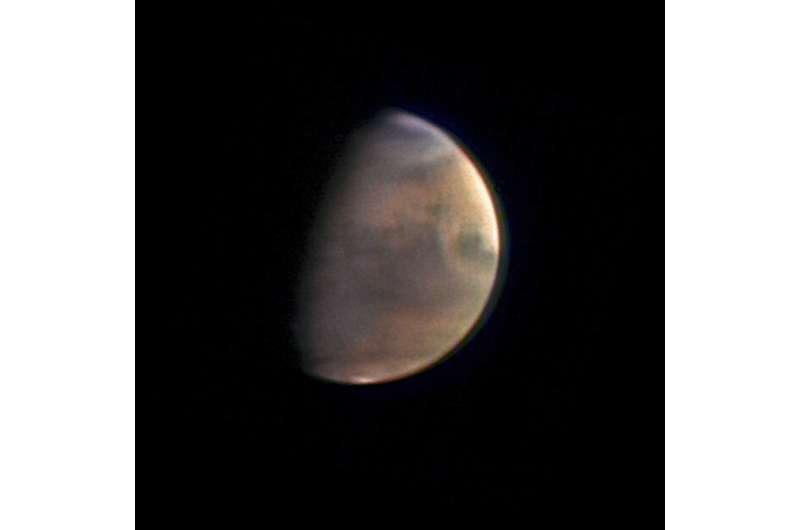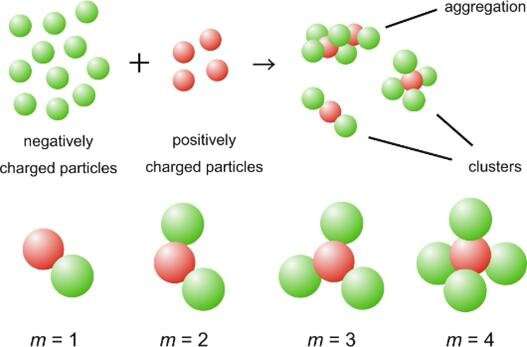Mars in colour as never seen before
Sunday, 04 June 2023 05:55
 Exactly 20 years ago, on 2 June 2003, the Mars Express spacecraft, the first European mission to explore another planet in the Solar System, launched on a Soyuz launch vehicle from the Baikonur Cosmodrome in Kazakhstan. A Fregat upper stage delivered the mission on a transfer orbit to Mars, which the spacecraft reached on 25 December of the same year. The High Resolution Stereo Camera (HRSC),
Exactly 20 years ago, on 2 June 2003, the Mars Express spacecraft, the first European mission to explore another planet in the Solar System, launched on a Soyuz launch vehicle from the Baikonur Cosmodrome in Kazakhstan. A Fregat upper stage delivered the mission on a transfer orbit to Mars, which the spacecraft reached on 25 December of the same year. The High Resolution Stereo Camera (HRSC),
Engineers test VIPER's very nimble gimbal
Sunday, 04 June 2023 05:55 As VIPER, NASA's next Moon rover, wheels about atop Mons Mouton - a large flat-topped mountain on the Moon's South Pole - one small but mighty piece of hardware will be critical for the team of rover drivers and scientists to send it commands, know where it is going, and receive valuable science data: a gimbal-pointed high-gain antenna.
VIPER has both a low-gain and high-gain antenna to tr
As VIPER, NASA's next Moon rover, wheels about atop Mons Mouton - a large flat-topped mountain on the Moon's South Pole - one small but mighty piece of hardware will be critical for the team of rover drivers and scientists to send it commands, know where it is going, and receive valuable science data: a gimbal-pointed high-gain antenna.
VIPER has both a low-gain and high-gain antenna to tr Mysterious dashes revealed in Milky Way's center
Sunday, 04 June 2023 05:55 An international team of astrophysicists has discovered something wholly new, hidden in the center of the Milky Way galaxy.
In the early 1980s, Northwestern University's Farhad Yusef-Zadeh discovered gigantic, one-dimensional filaments dangling vertically near Sagittarius A*, our galaxy's central supermassive black hole. Now, Yusef-Zadeh and his collaborators have discovered a new populati
An international team of astrophysicists has discovered something wholly new, hidden in the center of the Milky Way galaxy.
In the early 1980s, Northwestern University's Farhad Yusef-Zadeh discovered gigantic, one-dimensional filaments dangling vertically near Sagittarius A*, our galaxy's central supermassive black hole. Now, Yusef-Zadeh and his collaborators have discovered a new populati Weigh a quasar's galaxy with precision
Sunday, 04 June 2023 05:55 A team of researchers from EPFL have found a way to use the phenomenon of strong gravitational lensing to determine with precision - about 3 times more precise than any other technique - the mass of a galaxy containing a quasar, as well as their evolution in cosmic time. Knowing the mass of quasar host galaxies provides insight into the evolution of galaxies in the early universe, for building s
A team of researchers from EPFL have found a way to use the phenomenon of strong gravitational lensing to determine with precision - about 3 times more precise than any other technique - the mass of a galaxy containing a quasar, as well as their evolution in cosmic time. Knowing the mass of quasar host galaxies provides insight into the evolution of galaxies in the early universe, for building s ESA launches major recruitment drive for 2023
Sunday, 04 June 2023 05:55 In an unprecedented move, the European Space Agency (ESA) has announced that it will be hiring over 200 new colleagues to join its teams in 2023. This large-scale recruitment drive aims to support ESA's ongoing mission of promoting the peaceful exploration and use of space for the benefit of everyone.
ESA recently published over 30 job vacancies and hinted at more to come. This opens a mul
In an unprecedented move, the European Space Agency (ESA) has announced that it will be hiring over 200 new colleagues to join its teams in 2023. This large-scale recruitment drive aims to support ESA's ongoing mission of promoting the peaceful exploration and use of space for the benefit of everyone.
ESA recently published over 30 job vacancies and hinted at more to come. This opens a mul Shenzhou XV crew lands in Inner Mongolia
Sunday, 04 June 2023 05:55 Completing a six-month mission that included the successful completion of the Tiangong space station, the Shenzhou XV mission crew returned to Earth early Sunday morning.
The crew's reentry capsule, carrying Major General Fei Junlong, the mission's commander, and Senior Colonels Deng Qingming and Zhang Lu, descended at the Dongfeng Landing Site, situated in northwestern China's Gobi Desert
Completing a six-month mission that included the successful completion of the Tiangong space station, the Shenzhou XV mission crew returned to Earth early Sunday morning.
The crew's reentry capsule, carrying Major General Fei Junlong, the mission's commander, and Senior Colonels Deng Qingming and Zhang Lu, descended at the Dongfeng Landing Site, situated in northwestern China's Gobi Desert UAE outlines plans for asteroid mission
Saturday, 03 June 2023 21:31
The United Arab Emirates has released new details about its planned mission to the main asteroid belt, one that is similar to an ongoing NASA mission.
Fixed-price satellite contracts earn high grades in Space Force report card
Friday, 02 June 2023 22:28
Military satellites acquired under fixed-price contracts get high praise in a report submitted to Congress by the Department of the Air Force.
Northrop Grumman gets $80 million Air Force contract for satcom experiments
Friday, 02 June 2023 21:59
The U.S. Air Force Research Laboratory awarded Northrop Grumman a contract worth $80.3 million to conduct communications experiments using multiple commercial space internet services.
First-of-its-kind Mars livestream by ESA spacecraft interrupted at times by rain on Earth
Friday, 02 June 2023 18:06
A European spacecraft around Mars sent its first livestream from the red planet to Earth on Friday to mark the 20th anniversary of its launch, but rain in Spain interfered at times.
Space-Comm Expo 2023 – Where Space Does Business
Friday, 02 June 2023 14:08
Experts and innovators from across the space sector supply chain are convening at Space-Comm Expo, taking place 7-8 June 2023 at Farnborough International Exhibition & Conference Centre.
Study reveals understanding of a basic physical property of charged particles in microgravity
Friday, 02 June 2023 13:01
A study conducted by group of scientists from Nagoya City University (NCU), Japan Space Forum (JSF), Advance Engineering Services (AES), Japan Aerospace Exploration Agency (JAXA) and ANSTO has revealed a clustering of charged particles in the microgravity environment of International Space Station (ISS), with implications for the development of photonic materials, improved drugs, and a range of new and innovative materials that depend on the mixing of two or more charged particles.
The experimental study, which was published in npj Microgravity, and conducted on the ISS, determined how sub-micron sized charged colloidal particles interact in the presence and absence of Earth's gravity.
Week in images: 29 May - 02 June 2023
Friday, 02 June 2023 12:10
Week in images: 29 May - 02 June 2023
Discover our week through the lens
Maritime Cleantech company selects Spire Global to provide ship-tracking data
Friday, 02 June 2023 11:59 Spire Global, Inc. (NYSE: SPIR) was selected by Navidium, an innovative software company active in the maritime industry, to provide real-time automatic identification system (AIS) vessel-tracking data.
Navidium will integrate the data into its Voyage Optimization and Environmental Compliance products to help users track vessel position along a route, reoptimize routes based on various con
Spire Global, Inc. (NYSE: SPIR) was selected by Navidium, an innovative software company active in the maritime industry, to provide real-time automatic identification system (AIS) vessel-tracking data.
Navidium will integrate the data into its Voyage Optimization and Environmental Compliance products to help users track vessel position along a route, reoptimize routes based on various con Pixxel raises $36M for hyperspectral satellite constellation
Friday, 02 June 2023 11:59 Pixxel, a leader in cutting-edge hyperspectral earth-imaging technology, announced $36 Million in a Series B funding round with participation from new investors such as Google, along with existing investors Radical Ventures, Lightspeed, Blume Ventures, growx, Sparta and Athera.
The new funds will advance Pixxel's mission to build the world's first and highest-resolution hyperspectral satel
Pixxel, a leader in cutting-edge hyperspectral earth-imaging technology, announced $36 Million in a Series B funding round with participation from new investors such as Google, along with existing investors Radical Ventures, Lightspeed, Blume Ventures, growx, Sparta and Athera.
The new funds will advance Pixxel's mission to build the world's first and highest-resolution hyperspectral satel 
